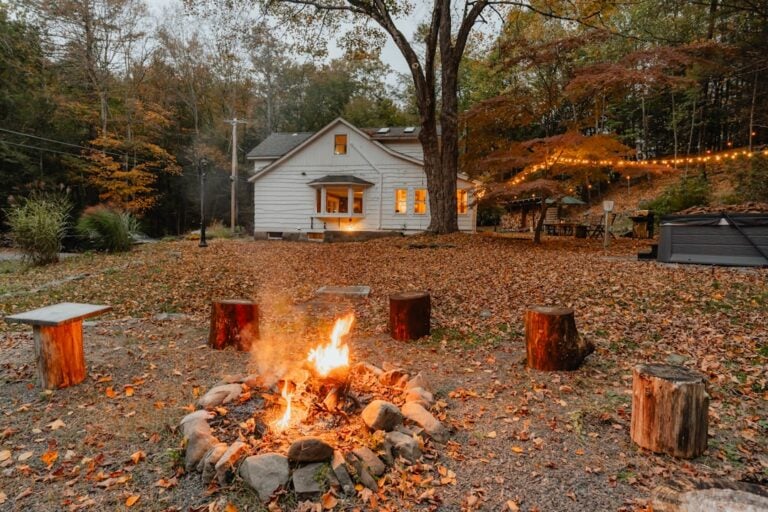Why Fire Pit Distance Matters for Your Home’s Safety
How far should fire pit be from house is a critical safety question. The recommended minimum distance is 10-25 feet from any structure, but this varies based on fire pit type, local rules, and conditions.
Here’s what you need to know:
- Wood-burning fire pits: 20-25 feet minimum from house, garage, or shed
- Gas/propane fire pits: 10-15 feet minimum (better flame control)
- Overhead clearance: 21-25 feet from branches, power lines, or covered structures
- Property lines: At least 10 feet from fences and neighboring properties
- Emergency equipment: Fire extinguisher, water source, and sand bucket within reach
Fire pits are popular but risky. The Consumer Product Safety Commission reported about 6,200 emergency room visits in 2021 from fire pit and outdoor heater injuries. A single spark can ignite siding, decks, or plants, causing devastating damage. The heat alone can warp vinyl siding, crack windows, and ruin outdoor furniture. Proper placement is about protecting your most valuable investment.
As Daniel Cabrera, founder of Fire Damage House Buyer with over 16 years of experience, I’ve seen how improper fire pit placement leads to disaster. After purchasing over 275 fire-damaged properties, I know prevention is key.
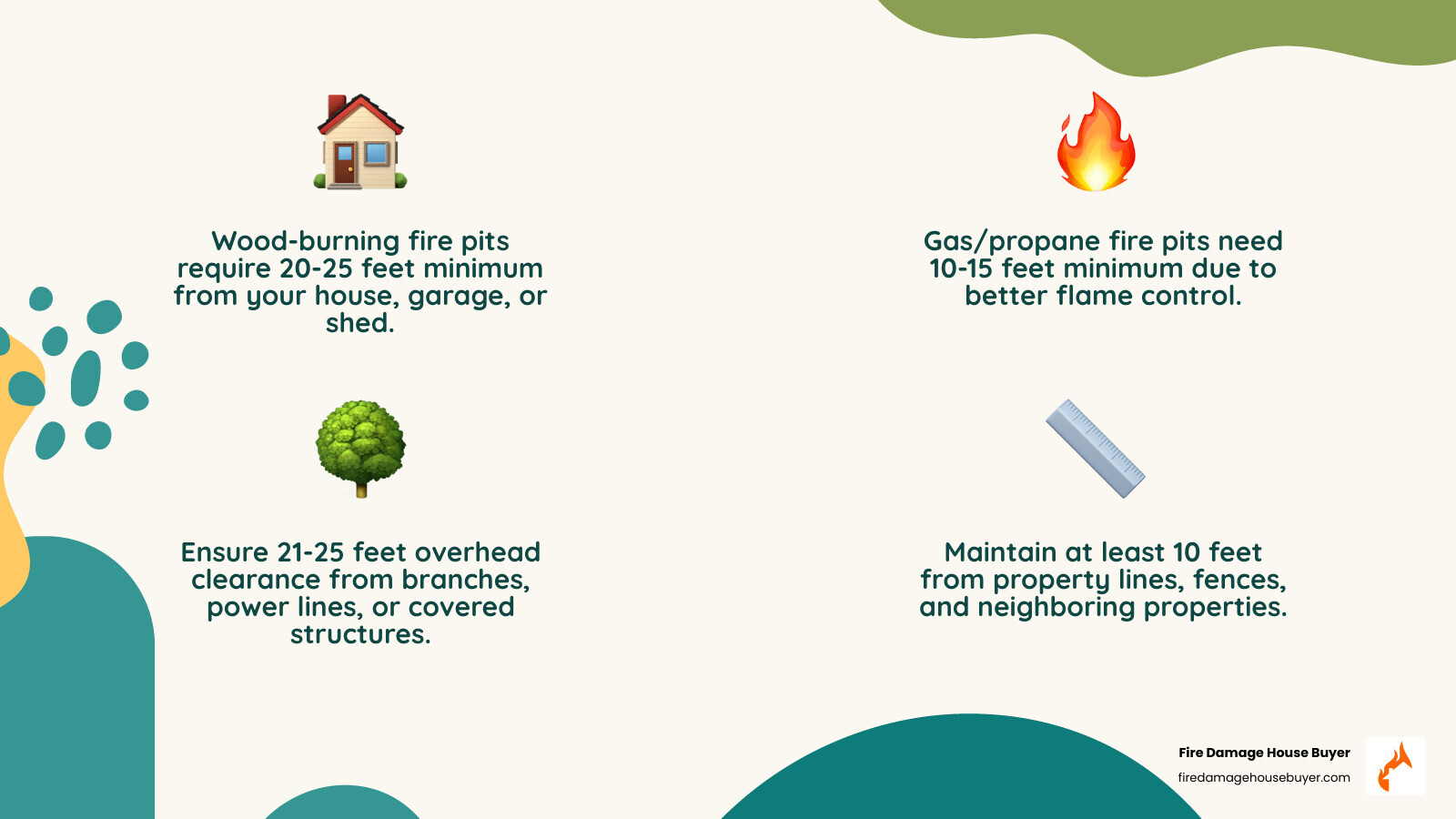
The “Golden Rule”: Recommended Fire Pit Distances
Understanding how far should fire pit be from house means respecting three dangers: radiant heat, flying sparks, and unpredictable flames. Sparks can travel up to 50 feet in the wind, and I’ve seen homes with melted siding from pits that seemed far enough away. The radiant heat alone can warp vinyl, crack windows, and damage your home’s exterior over time.
The National Fire Protection Association (NFPA) recommends a 10-foot minimum from any structure, but experts suggest more. The ideal distance is 20-25 feet from your house for wood-burning pits, a distance often required by local fire codes. These codes are not suggestions; violating them can void your homeowner’s insurance. Always check with your local fire department before installation.
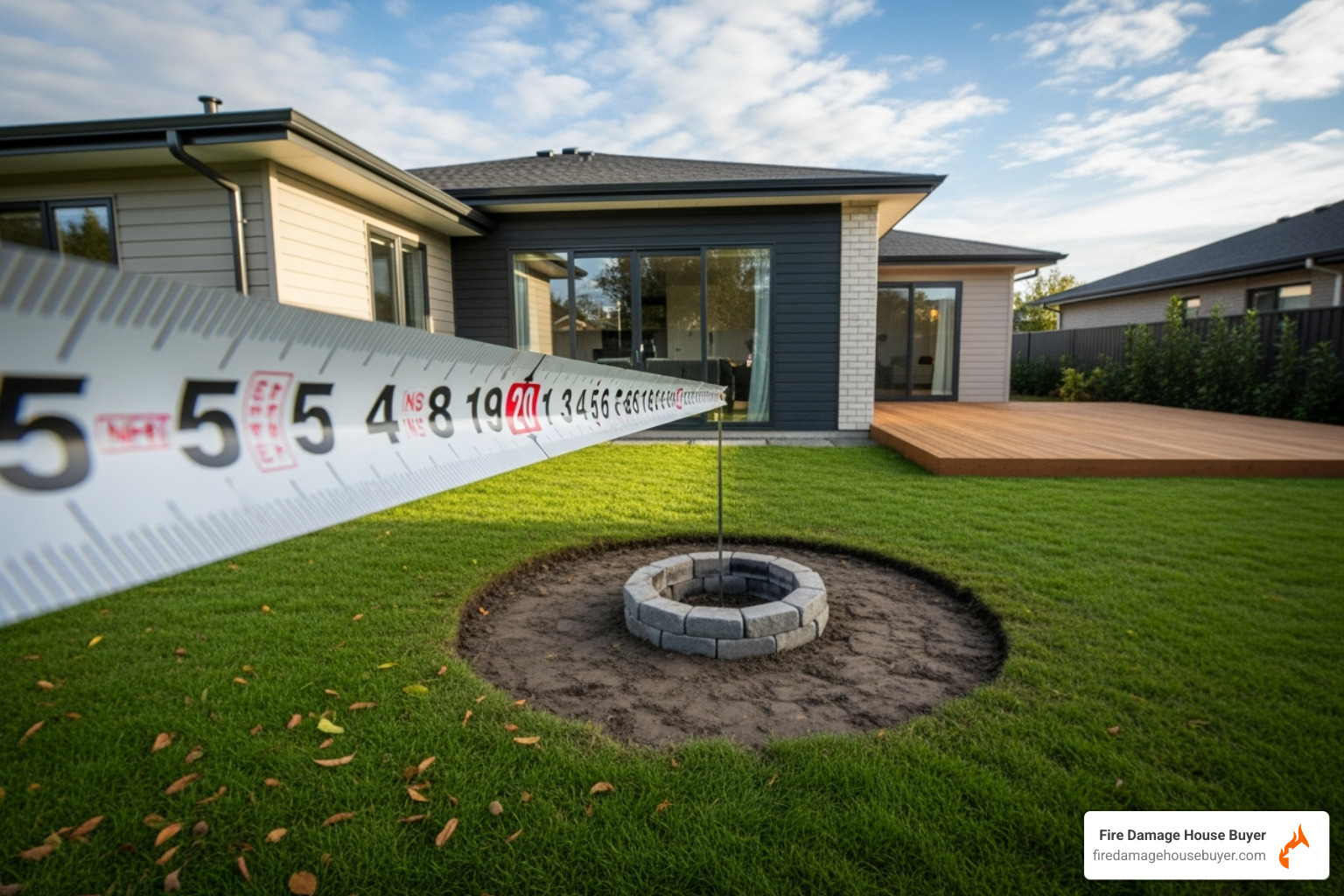
How far should a fire pit be from the house based on fuel type?
The fuel you use significantly impacts the safe distance. Wood-burning and gas fire pits have very different safety profiles.
| Feature | Wood-Burning Fire Pits | Gas/Propane Fire Pits |
|---|---|---|
| Recommended Distance from House | 20-25 feet minimum from house, garage, or shed | 10-15 feet minimum (some sources suggest 5-10 feet) |
| Spark Risk | High (embers can fly far, especially in wind) | Very Low (no flying embers) |
| Maintenance | Requires cleaning ashes, managing wood supply | Minimal (no ash, occasional burner cleaning) |
| Control Level | Less control over flame size and intensity | Excellent control (instant on/off, adjustable flame) |
Wood-burning fire pits are classic but dangerous due to sparks that can land on your roof or ignite dry leaves. Place them at least 20-25 feet from any structure, including your house, garage, shed, or pergola. Sparks from softwoods like pine travel far, so seasoned hardwood is a safer choice.
Gas and propane fire pits offer better control and less risk. With no flying embers, you can typically place them 10-15 feet from your house. Some manufacturers suggest 5-10 feet for smaller units, but I recommend the greater distance for safety. The instant on-off control is a major advantage if conditions change.
Essential Overhead and Surrounding Clearances
Looking up is as important as measuring horizontally. You need 21-25 feet of clear space above your fire pit, free of low-hanging branches, power lines, or covered structures. Tree branches are especially dangerous as they can ignite and spread fire to your roof.
Fences require at least 10 feet of clearance, particularly vinyl fences that can melt from radiant heat. I’ve seen expensive vinyl fences destroyed simply by being too close.
Property lines also matter, with most ordinances requiring at least 10 feet of clearance. This respects your neighbors and prevents smoke from becoming a nuisance. Consider the prevailing wind direction and position your pit so smoke and sparks blow away from neighboring properties. Pergolas and covered patios can trap heat, creating dangerous conditions even with adequate vertical clearance.
How far should fire pit be from house: Beyond the Basics
True fire pit safety goes beyond basic distances. You must consider environmental factors, surface materials, and local laws.
Wind is a major unpredictable danger. A sudden gust can carry sparks much farther than expected, turning a controlled fire into a hazard. If possible, it’s recommended to check wind speed and direction before lighting a fire, and avoid use when winds exceed 10-15 mph. When choosing a permanent spot, consider the prevailing wind direction to ensure smoke and sparks are carried away from structures.
Choosing a Safe Surface and Location
The ground beneath your fire pit is as important as its distance from your house. I’ve seen homes damaged because pits were placed on unsafe surfaces.
Safe surfaces include concrete, stone pavers, brick, and gravel. These non-combustible materials can handle intense heat.
Never place a fire pit directly on wooden decks, composite decking, or dry grass. Wood is an obvious hazard, while composite materials can melt, warp, or release toxic fumes. Even fire-resistant mats don’t eliminate the risk on combustible surfaces.
Clear a non-flammable surface zone of at least 10 feet in all directions around your pit. Remove dry leaves, pine needles, mulch, and anything else that could ignite.
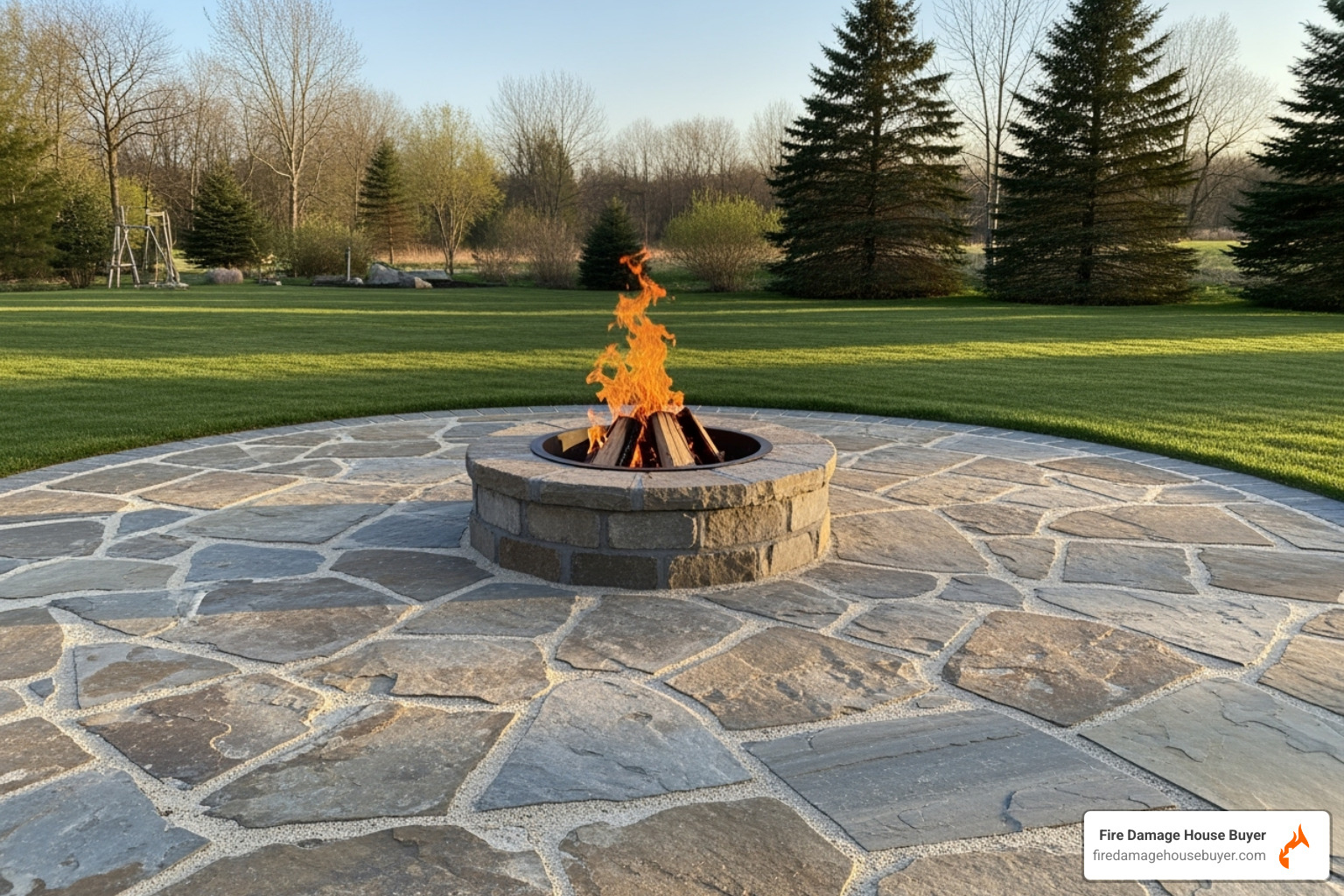
Understanding Local Regulations and HOA Rules
Local regulations can override general safety recommendations, and violations can lead to hefty fines. I’ve seen homeowners face thousands in penalties for not following local rules.
- Your local fire department is the best source for specific requirements in your area.
- Check your municipal website for fire codes and burning restrictions, which may be seasonal.
- Be aware of burn bans, which are temporary restrictions prohibiting all outdoor fires.
- If you have a homeowners association, check its HOA rules, as they may be stricter than city codes. Some HOAs ban wood-burning pits entirely.
- Permanent fire pit installations often require building permits to ensure they meet all safety codes.
Following these rules isn’t just about avoiding fines; it protects your property, neighbors, and insurance coverage.
Essential Fire Pit Safety and Emergency Preparedness
Proper placement is just the start. Since fires are unpredictable, being prepared for emergencies is crucial to prevent a minor scare from becoming a devastating loss. Most homeowners don’t expect trouble, but proper fire management and preparedness are key.
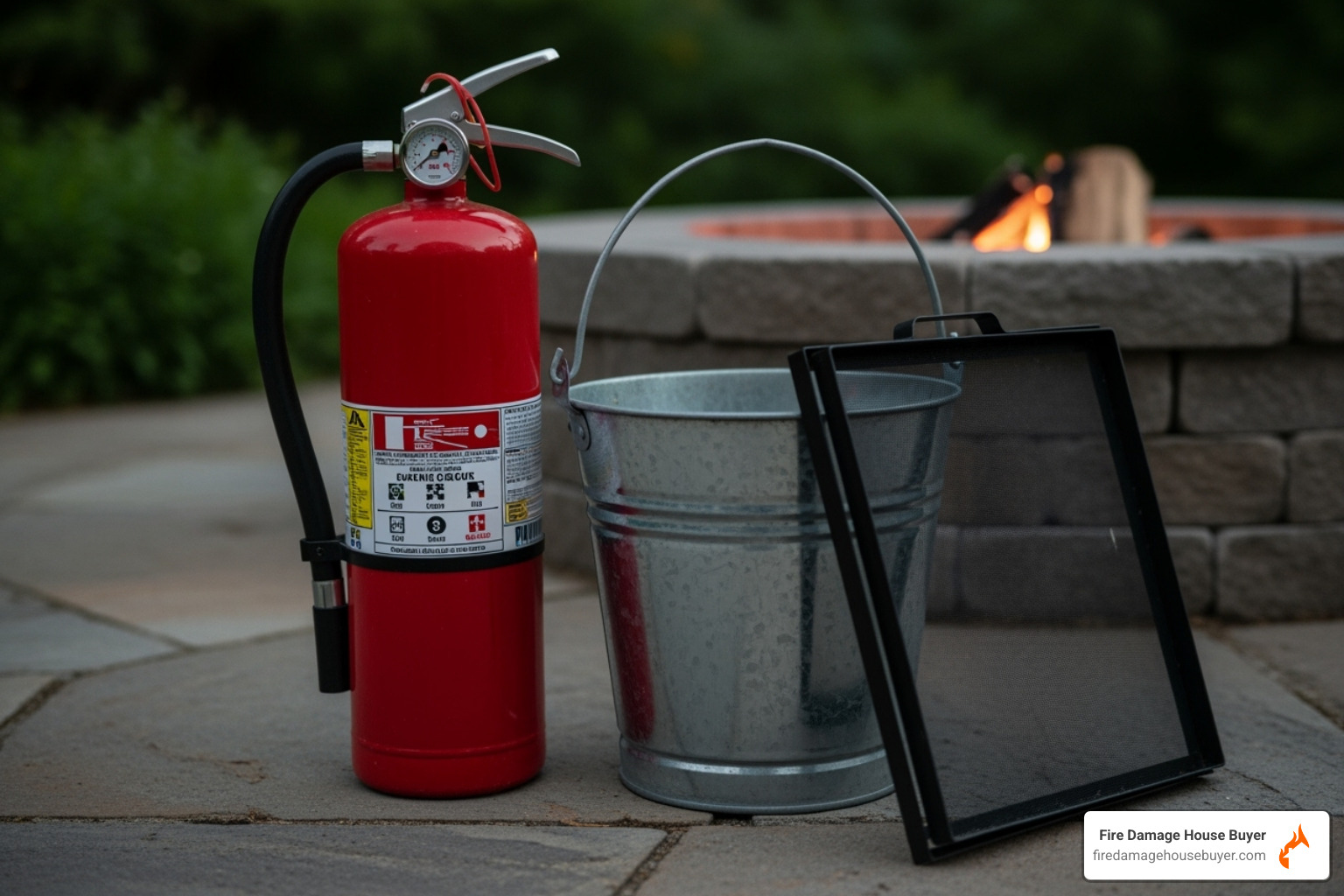
Fuel, Ignition, and Fire Management Best Practices
The fuel you choose and how you manage it directly impacts safety.
- For wood-burning pits, use dry, seasoned hardwood like oak or hickory. It burns cleaner with fewer sparks. Logs should be no longer than three-quarters of the pit’s diameter.
- Never burn treated lumber, plastics, or trash, as they release toxic fumes and can cause flare-ups. Avoid green or wet wood, which creates excess smoke and can pop explosively.
- For safe ignition, use natural kindling or commercial fire starters. Never use accelerants like gasoline, which can cause dangerous flashbacks. Use long-handled lighters.
- Constant adult supervision is non-negotiable. A responsible adult must be present until the fire is completely out and cold.
- Keep flames manageable (no more than 3 feet high) and always use a spark screen to contain embers.
How to Extinguish a Fire Pit and Be Prepared for Emergencies
Properly extinguishing a fire prevents it from rekindling.
- For wood fires, let them burn down to coals, then slowly douse with water until all sizzling stops. Stir the ashes to expose hot spots and douse again. If water could damage your pit, use a bucket of sand to smother the flames.
- For gas fires, simply turn off the gas supply at the source.
Emergency equipment should always be within reach: a connected garden hose, a dry-chemical fire extinguisher (Class B and C), and a bucket of sand or dirt. Familiarize yourself with the PASS technique for fire extinguishers: Pull, Aim, Squeeze, Sweep.
Small fires escalate quickly. Understanding How Hot Does a House Fire Get? shows why swift action is critical, as house fires can exceed 1,000°F in minutes.
Dispose of cool ashes in a metal container with a lid, stored away from combustibles. Never bury hot coals.
When Fire Pit Safety Fails: The Aftermath of a Fire
Even with precautions for how far should fire pit be from house, accidents happen. An unexpected wind gust or a stray ember can turn a peaceful evening into a nightmare. I’ve seen the devastation firsthand, and the consequences can last for years.
Property damage from fire pit accidents can be staggering. A small outdoor fire can quickly spread to your siding, deck, and home. The intense heat alone warps vinyl, cracks windows, and damages structures. Once flames reach the house, they can destroy the roof, attic, and cause smoke damage everywhere.
The financial burden is often overwhelming. Restoration costs of a burned house can range from $15,000 to $50,000 for moderate damage and can exceed $100,000 to $300,000 for structural repairs, not including temporary housing or lost belongings.
The emotional toll can be even more devastating. Families feel violated, unsafe, and overwhelmed. Recovery is complex and exhausting, involving a difficult Fire Damage Insurance Claim process and finding contractors for Fire Damage Restoration, often while in temporary housing.
Many families face an impossible choice: endure months of stressful repairs or start fresh. The trauma of the fire and the stress of restoration is often too much. Understanding How Hot Does a House Fire Get explains why damage is so extensive, with temperatures over 1,000°F requiring complete reconstruction.
For homeowners in this situation, selling the property as-is is an attractive alternative. We help families move forward by purchasing their homes for cash without any repairs.
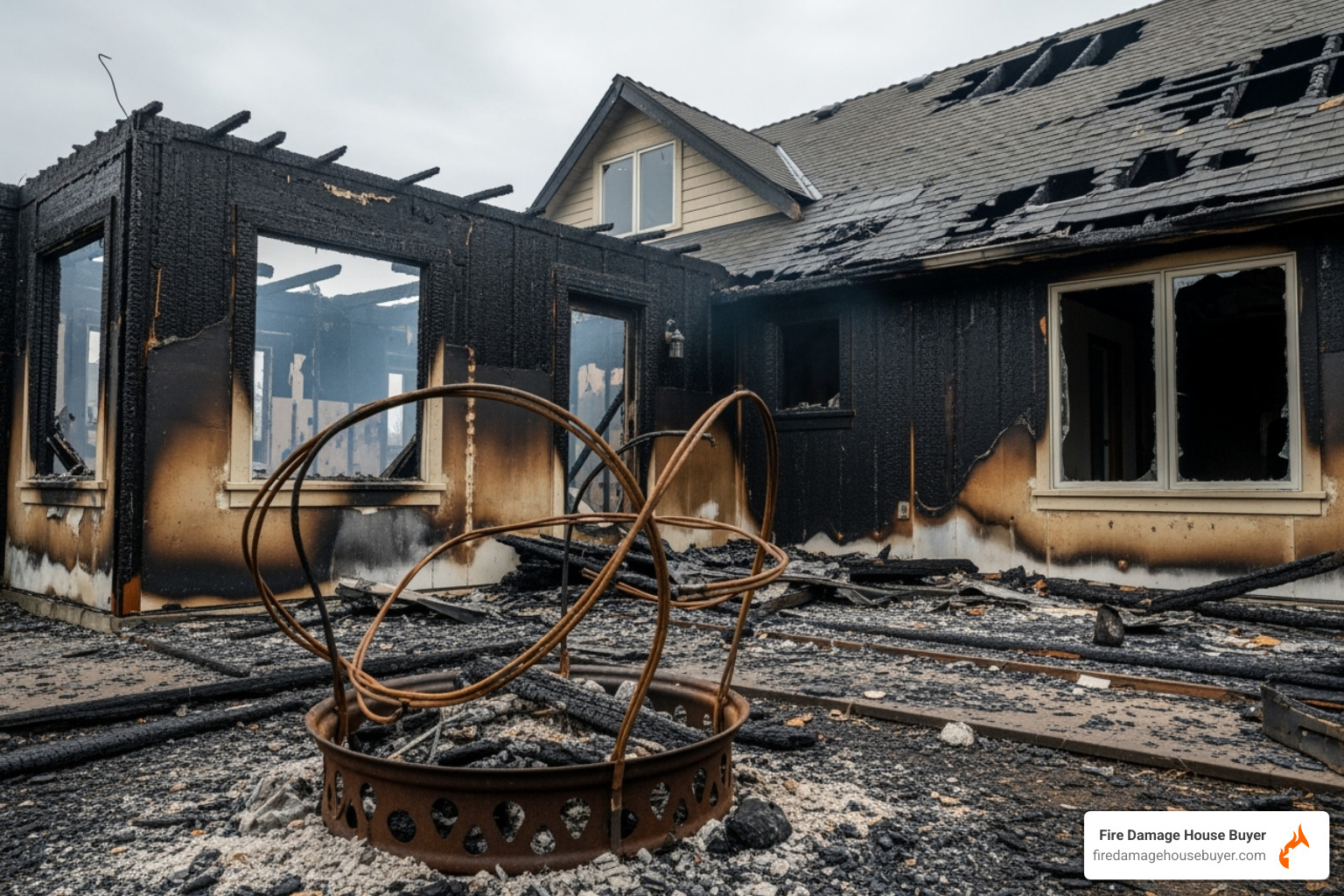
Frequently Asked Questions about Fire Pit Placement
As a fire damage expert, I’m often asked about fire pit placement, usually after a close call. Here are the most common questions and answers that could save your home.
Can I put a fire pit on my wooden or composite deck?
The short answer is no. I’ve purchased dozens of homes where this led to devastating fires. Placing a fire source on combustible materials negates any other safety distances.
The intense radiant heat can ignite wood or composite decking without direct flame contact. Wood-burning pits are especially dangerous due to flying sparks. Even gas pits generate enough heat to warp composite decking or scorch wood. Deck replacement alone can cost $15,000 to $45,000, not including house damage.
A safer alternative is to place your fire pit on a concrete pad or stone patio at least 15-20 feet from the deck. Fire-resistant mats reduce risk but don’t eliminate it. Always check manufacturer guidelines and local codes, as some municipalities prohibit fire pits on any wooden surface. Your insurance might also have exclusions for such placement.
What’s the minimum distance a fire pit should be from a vinyl fence?
Keep your fire pit at least 10-15 feet from any vinyl fence. This prevents not just fire but also melting. Vinyl’s melting point is low (around 200°F), and radiant heat from a fire pit can easily reach that temperature from 10 feet away, causing panels to warp and discolor.
Replacement costs for vinyl fencing can be $25-40 per linear foot. If the fence connects to your vinyl siding, the damage can spread to the house, costing $8,000-15,000 or more to repair. Always consider wind direction, which can push hot air toward your fence.
Do I need a permit for a portable fire pit?
Most portable fire pits don’t require permits, but permanent installations almost always do.
Portable fire pits are usually considered “recreational fires” and don’t need a building permit. However, you must still follow all safety regulations for distance, fuel, and burn restrictions, including knowing how far should fire pit be from house in your area.
Permanent, built-in fire pits require building permits and inspections. The permit process ensures your installation meets safety standards and won’t cause insurance problems.
Always call your local fire department first. They know the current regulations and can save you from fines of $500-2,000 or more. Some insurance companies have denied claims for non-compliant fire pits. Also, check your HOA rules, which may be even stricter.
Conclusion: Enjoy Your Fire Pit Responsibly
The answer to how far should fire pit be from house is clear: maintain at least 10-25 feet from any structure, with wood-burning pits needing 20-25 feet and gas pits 10-15 feet. Also ensure 21-25 feet of overhead clearance.
Responsible ownership means following local fire codes and HOA rules, choosing a safe surface like concrete or stone (never a deck), using proper fuel, and having constant adult supervision. Keep emergency equipment handy and always extinguish your fire completely until it’s cold to the touch.
Even with perfect safety, accidents happen. The restoration process after a house fire is overwhelming, with costs ranging from $15,000 to over $100,000, plus immense emotional stress.
If you’re dealing with fire damage and overwhelmed by repairs and insurance claims, you have another option. We purchase fire-damaged houses across all states, paying cash for properties as-is. No repairs, no commissions, and a fast closing allow you to move forward. Learn how to sell a fire-damaged house without the stress of restoration.

